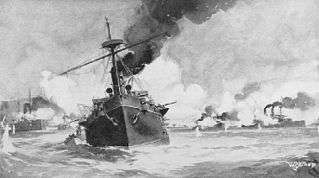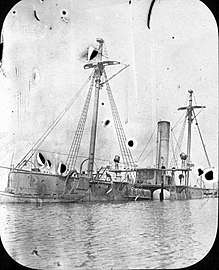Patricio Montojo y Pasarón
| Patricio Montojo | |
|---|---|
 | |
| Nickname(s) | "The fighting Montojo"[1] |
| Born |
September 7, 1839 Ferrol, Galicia, Spain |
| Died |
September 30, 1917 (aged 78) Madrid, Spain |
| Allegiance |
|
| Service/ |
|
| Years of service | 1855–1899 |
| Rank |
(Rear Admiral) |
| Commands held | Pacific Squadron |
| Battles/wars | |
Rear Admiral Patricio Montojo y Pasarón (September 7, 1839 – September 30, 1917) was a career Spanish naval officer who commanded the restored Kingdom of Spain's Pacific Squadron based in the Philippines during the Spanish–American War. Considered to have been a man of high ability and experience, he was given what was regarded as an impossible task of defending the Spanish Philippines with antiquated ships and low supplies against the more formidable U.S. Asiatic Squadron. Montojo became known for his defeat at the Battle of Manila Bay (1 May 1898) by U.S. Navy Commodore George Dewey, being a decisive naval battle of the war. After the conflict, the rear admiral was held accountable for the defeat and was court-martialed, but that was later overturned, though Montojo was still discharged from the Spanish Navy.
Early life and career
Born in Ferrol, Galicia, Montojo studied at the Naval School in the southern Spanish city of Cádiz, and was assigned as a midshipman in 1855. By 1860, he had become a sub-lieutenant and fought against the Moros of Mindanao in the Philippines before returning to Spain in 1864. During his stay in the Philippines, the Spanish officer visited China and the French colony in southern Vietnam.[2]
Montojo fought in the Battle of Abtao and the Battle of El Callao under Admiral Casto Méndez Núñez against Peru and subsequently assumed a post at the Secretariat of the Admiralty. He was promoted to the rank of Commander in 1873. His new duties included commanding several warships at the Havana naval station as well as those in the Río de la Plata. Montojo remained in Madrid until November 1891, when he was promoted to the flag officer rank. In 1892 he became a candidate for the Order of Isabella the Catholic and in 1897 he received the Military Order of María Cristina.[2][3][4]
Service in the Philippines

By 1898, Montojo returned to the Philippines as rear admiral, serving as general commander of all Spanish Philippine naval stations and taking part in operations against Filipino insurgents.[2] At a meeting with the colony's captain general, Basilio Augustín, on March 15, 1898, he expressed his concerns that their forces would be destroyed by the Americans in battle because of their disadvantages, as it became apparent that war with the United States was increasingly likely.[5] Of the thirty-seven ships in the Spanish naval fleet stationed in the Philippines, the majority were small gunboats, so there were only seven ships that would be used to take on the U.S. Asiatic Squadron.[3] In addition, there were other problems facing the Spaniards. Their force did not possess enough adequate mines, and some of the ones they did have were missing components. The admiral requested additional supplies from the homeland but these were ultimately not delivered.[6] In the end, Montojo decided to send the squadron to Subig Bay to the northwest of Manila, which would be easier to defend for the Spanish when the American ships arrived. If they ignored them and headed for Manila, he believed his squadron could then head back and ambush the U.S. squadron at night.[5]
However, by the time the Americans arrived and checked at Subic on April 30, they found no Spanish ships there. That was because Montojo had judged the position to be indefensible because they had not finished installing the naval guns on the ground at the entrance to Subic, being behind schedule—though according to American scouts, the guns were lying on the beach and could have been mounted in less than 24 hours. In addition, the wooden cruiser Castilla was having technical problems. Thus a council of squadron captains decided to return to Manila Bay. Reportedly, another factor in Admiral Montojo's decision was that they would not be able to save Spanish sailors in the depth of forty meters of water at Subic, something which American naval officers found astounding. Thus the American squadron leader, Admiral George Dewey, and his other officers initially had a low opinion of the Spanish commander's abilities.[4]

The American ships passed into Manila Bay without striking the few mines that the Spaniards had emplaced (the water was too deep and the waterway was too wide for them to be of much use), and aside from artillery fire from the guns on Corregidor island, did not meet much resistance. They entered the bay without any losses. Meanwhile, the Spanish ships were anchored at the naval arsenal near Cavite, where Montojo—pessimistic about the battle—believed his men would have the best chance of survival.[5][7] The engagement that followed between the Spanish squadron and the Americans became the first major naval battle that Montojo had fought in for over thirty years.[1] The US squadron arrived near Cavite and engaged the Spanish under Montojo on May 1, 1898, around 5:00 in the morning. By 5:40, despite the fire from the shore artillery and Montojo's squadron, none of the US ships had been damaged. The American squadron returned fire and Montojo's flagship, the cruiser Reina Cristina, sustained heavy damage along with the rest of the Spanish ships, forcing the admiral to move his flag to the Isla de Cuba. The captain of a British steamer that was passing by at the time noted that "[Montojo] stood upright in the stern perfectly unmoved, although splashes of water flew repeatedly over the little craft ... it was an example of unparalleled heroism."[5][8]
By 7:30 in the morning, the Asiatic Squadron withdrew to restock their ammunition and provide rest for the crew. The only American casualties had been eight wounded aboard the USS Baltimore and one death on the USS McCulloch. After about three and a half hours, at around 11:15 a.m., the American ships returned to face the Spanish again. However, by then much of the Spanish squadron was destroyed and resistance was limited, and not long afterwards the Spaniards surrendered. Montojo reported around 381 casualties for his squadron in total, and among the wounded was one of his two sons.[5][9]
Later life
After the defeat at Manila Bay, Contraalmirante Patricio Montojo y Pasarón was recalled to Madrid to be held as a scapegoat for the loss by the court-martial despite the circumstances that led to the defeat. He left Manila in October and arrived in November 1898. By decree of the court-martial, he was imprisoned in March 1899, but was later released. Among the testimony was Admiral George Dewey, to whom Montojo had sent a letter asking for assistance, and the American officer replied that "Although without accurate knowledge as to the condition of your ships, I have no hesitation in saying to you what I have already had the honor to report to my government, that your defense at Cavite was gallant in the extreme. The fighting of your flagship, which was singled out for attack, was especially worthy of a place in the traditions of valor of your nation." Montojo was later absolved of the charges but was still discharged from the Spanish Navy.[2][3] In June 2017, a screenplay was written based on Montojo's court-martial and Admiral Dewey assisting him in March 1899.[10]
He died in Madrid on September 30, 1917.[2]
Personal life
Montojo wrote a number of literary works and articles for various publications.[3] Among those was León Aldao, A Critical Essay on the First Lands Discovered by Columbus, and Encyclopedic Nautical Handbook, as well as translations of Angelo Secchi's book on physics and The Two Admirals by James Fenimore Cooper.[11]
Awards
![]()
![]()
See also
Sources
Notes
- 1 2 Leeke (2009), pp. 48–49
- 1 2 3 4 5 Ponset, Joe. Admiral Patricio Montojo y Pasarón. Spanish–American War Centennial website. Retrieved 14 August 2017.
- 1 2 3 4 Dyal (1996), p. 228
- 1 2 Leeke (2009), pp. 55–56
- 1 2 3 4 5 George Dewey. US Navy official website. Retrieved 14 August 2017.
- ↑ Poncet, Jose. Mines. Spanish–American War Centennial website. Retrieved 14 August 2017.
- ↑ Leeke (2009), pp. 60–61
- ↑ Leeke (2009), pp. 64–68
- ↑ Leeke (2009), pp. 72–73
- ↑ Posadas, Dennis. Admiral Montojo: A Historical Drama Stage Play script. Amazon. Published 9 June 2017. Retrieved 14 August 2017.
- ↑ Poncet, Jose. Admiral Montojo's Literary Works. Spanish–American War Centennial website. Retrieved 14 August 2017.
External links
- Battle of Manila Bay, 1 May 1898 from Naval Historical Center
- Profiles of Key Persons in the Spanish American War
- Admiral Patricio Montojo y Pasarón